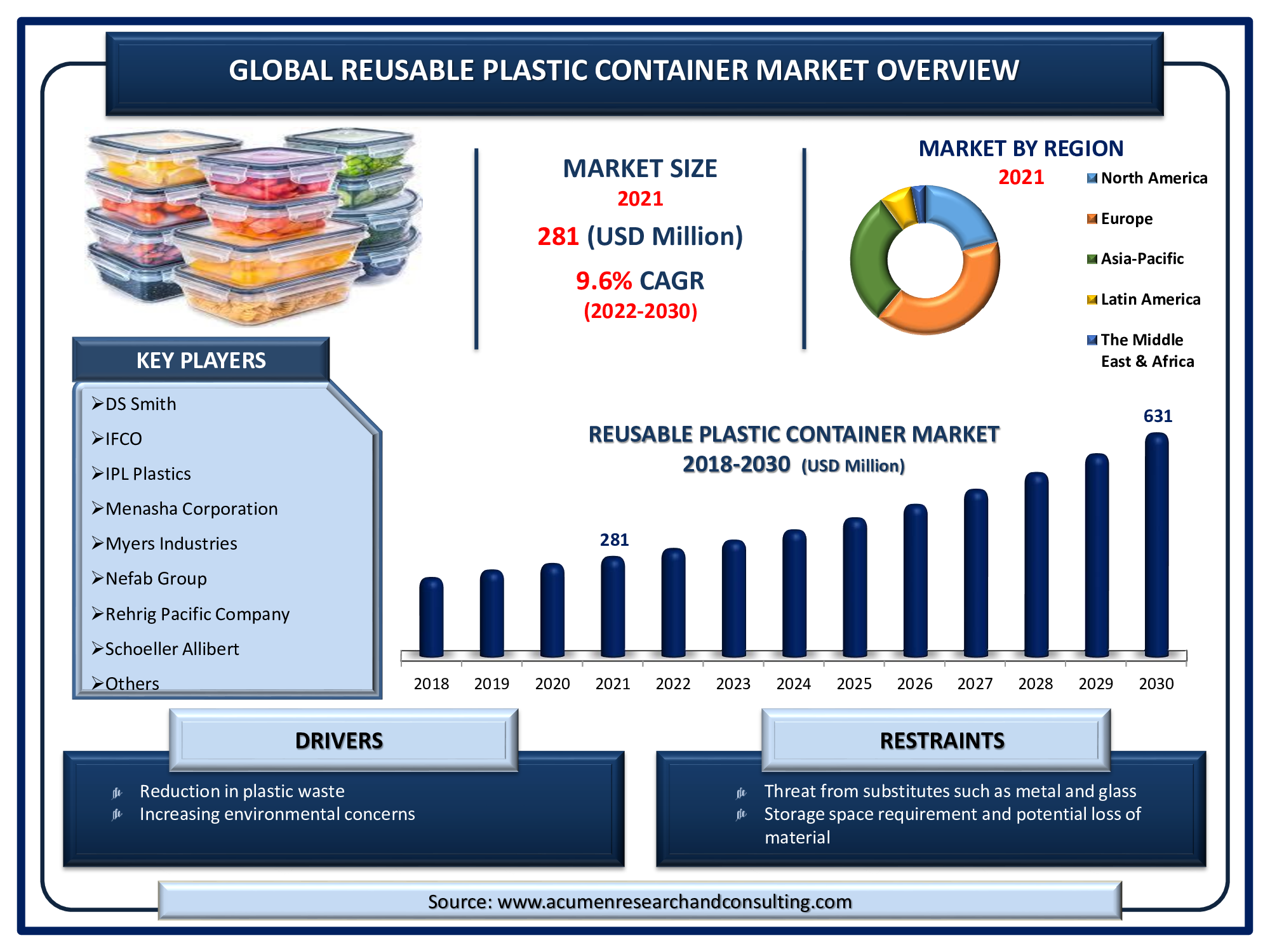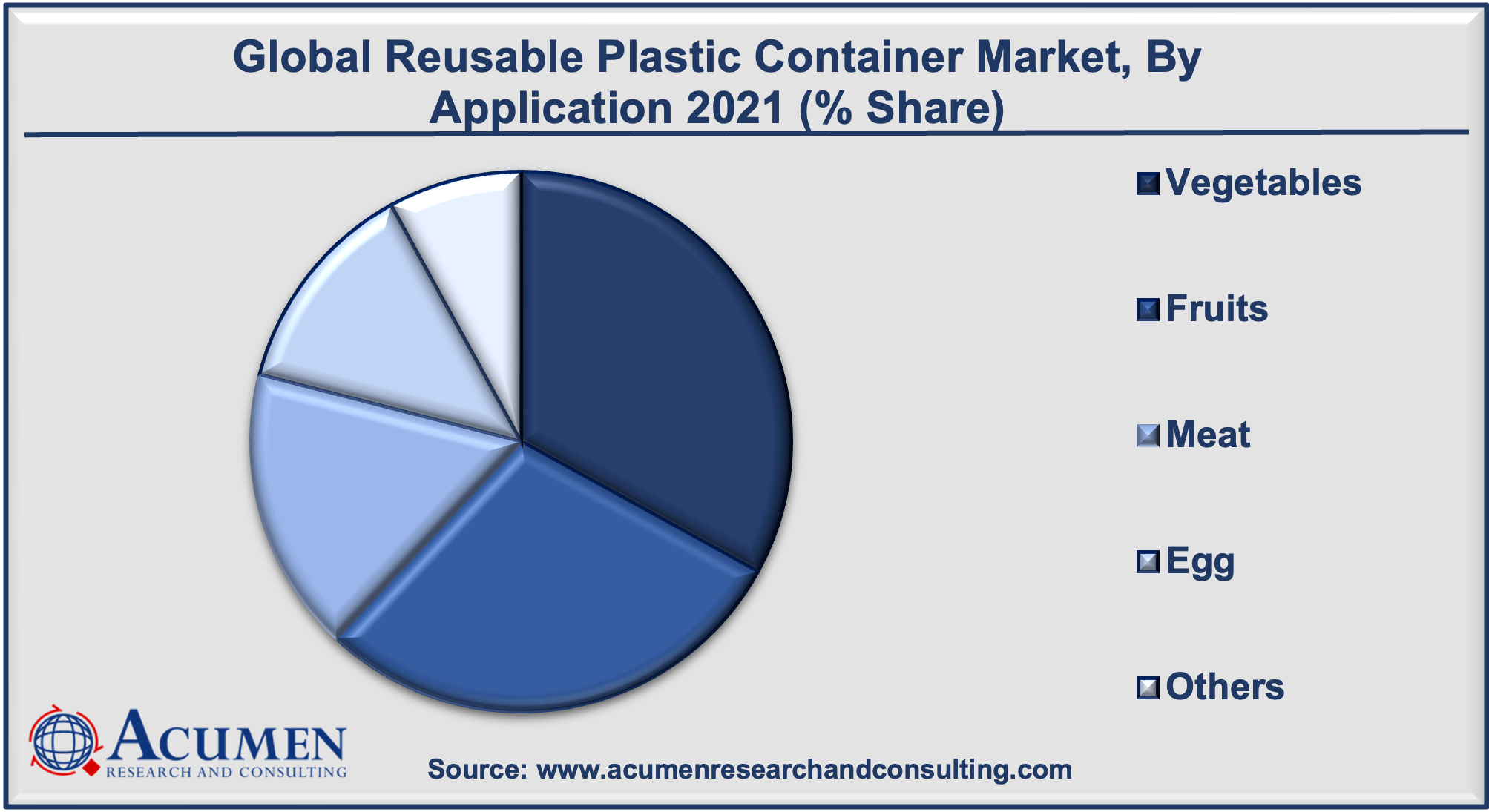April 2023
Reusable Plastic Container Market is estimated to reach the market value of USD 631 Million by 2030, with a CAGR of 9.6%
The Global Reusable Plastic Container Market size was valued at USD 281 Million in 2021 and is estimated to reach the market value of USD 631 Million by 2030, with a CAGR of 9.6% from 2022 to 2030.

The term "reusable plastic containers," or RPCs, refers to plastic trays, totes, cartons, sleeves, and bulk containers. In a range of manufacturing and distribution applications, these plastic bins are rapidly replacing paper corrugated boxes. Over 70% of Fortune 500 firms now have sustainability criteria in place, many of which typically involve returnable packaging. These containers are most familiar for packaging food, beverages, and pharmaceuticals. Because of its lightweight, durability, UV protection, and non-permeability to moisture, reusable plastic-based containers are becoming more popular for packaging food products. One of the efficient and cost-effective strategies to lessen the environmental impact of packaging is to reuse containers. This trend in the reusable plastic container market is expected to drive demand from 2022 to 2030.
Reusable Plastic Container Market Dynamics
Market Growth Drivers:
Market Restraint:
Market Opportunities:
Report Coverage
| Market | Reusable Plastic Container Market |
| Market Size 2021 | USD 281 Mn |
| Market Forecast 2030 | USD 631 Mn |
| CAGR During 2022 - 2030 | 9.6% |
| Analysis Period | 2018 - 2030 |
| Base Year | 2021 |
| Forecast Data | 2022 - 2030 |
| Segments Covered | By Type, By Application, And By Geography |
| Regional Scope | North America, Europe, Asia Pacific, Latin America, and Middle East & Africa |
| Key Companies Profiled | DS Smith, IFCO, IPL Plastics, Menasha Corporation, Myers Industries, Nefab Group, Rehrig Pacific Company, SchoellerAllibert, Schütz GmbH & Co. KGaA, and Vetropack Holding |
| Report Coverage |
Market Trends, Drivers, Restraints, Competitive Analysis, Player Profiling, Regulation Analysis |
| Customization Scope |
10 hrs of free customization and expert consultation |
According to the Reusable Packing Association, in 2020, the global packaging market size accounted for about US$ 950 billion in value. One of the very significant benefits offered by reusable packaging is that consumers can use the product multiple times and thus limit the plastic waste. According to the Ecology Center Organization, a number of plastic containers can be reused and refilled at least 25 times before becoming too dented to reuse. As a result, reusing and refilling plastic containers straightaway reduces the requirement for disposable plastic. These factors have supported the worldwide reusable plastic container market revenue to expand rapidly.
According to the Reusable Container & Pallet Association (RCPA), containers are essential for shipping, distributing, and storing practically all items and commodities. Plastic containers provide advantages for efficient and sustainable operations. Plastic containers offer several advantages including hygiene, consistent quality and dimension, no water absorption, and no splintering or nails. Plastic containers are weather-resistant, stack and nest for optimal space use, and are readily repaired or replaced.
The increasing environmental concern due to the use of single-use plastics is expected to support the reusable plastic industry. Plastic overconsumption and garbage management are becoming a rising problem, causing landfills to overflow, clogging rivers, and endangering marine habitats. This has a negative influence on industries vital to many economies, such as tourism, shipping, and fishing. Thus, reusable plastic containers have the potential to significantly reduce plastic waste. The growth of the food and beverage industries, combined with expanding e-commerce sales, has increased the demand for reusable plastic packaging. The gradual but steady increase in awareness to limit plastic waste in emerging countries is also likely to boost the reusable plastic container market share.
However, competition from equivalents such as metal and glass containers will stifle market growth. Because of the concept of prohibiting plastic, consumer moves toward these materials may constrain market growth. Glass, for example, remains the most practical alternative for reusable containers due to its long history of proven effectiveness. In addition to that, metal packaging has an almost infinite lifespan, allowing for a variety of uses, such as filling or reusing it, hence reducing disposable waste. Furthermore, logistics issues can be problematic if there is a poor relationship with the consumer or if a decent return system is not in place. Containers can go missing, causing a costly problem. This factor may also restrict the market from growing.
Reusable Plastic Container Market Segmentation
Type, application, and geography are all used to segment the worldwide reusable plastic container market.
Market by Type
On the basis of type, the handheld storage containers segment achieved a substantial growth rate throughout the forecast timeframe 2022 – 2030. The booming food and beverage sector, the expanding e-commerce industry, and the surge in the cosmetic industry are all aspects driving the handheld storage containers market. Furthermore, the COVID-19 pandemic has raised sales of handheld storage containers as a result of the higher consumption of sanitizer bottles and online delivery packing. Meanwhile, the bulk containers segment acquired an impressive market share in 2021, due to their rising adoption in transportation and logistics companies. Large corporations, for example, utilize rectangular-shaped Intermediate Bulk Containers (IBCs) since they allow containers to be placed closer together with less void space between them.
Market by Application

Based on applications, the vegetable segment occupied the maximum market share in 2021 and is anticipated to continue this trend throughout the forecasted years. In the transportation of vegetables, reusable plastic containers provide excellent product preservation and temperature management. Reusable plastic containers help to maintain and extend the freshness of fresh produce veggies when traveling long distances. Owing to these benefits companies have shifted their focus towards reusable packaging for their vegetables and fruit packaging. For instance, on February 8, 2021 – Walmart and IFCO SYSTEMS (IFCO) announced a multi-year commercial partnership that will expand the retailer's use of IFCO reusable plastic containers (RPCs) and establish IFCO Walmart's sole RPC packaging provider for select fresh vegetables and fruits supplied in the United States.
Reusable Plastic Container Market Regional Overview
North America
Europe
Latin America
Asia-Pacific
The Middle East & Africa (MEA)
Stringent Regulations for Plastic Waste Boost the Europe Reusable Plastic Container Market Growth
Based on regional analysis, Europe accounted for the maximum market share in 2021 owing to the strict government regulations regarding the use of single-use plastic and plastic waste. According to the Institute for European Environmental Policy, the packaging and food industries should prioritize learning how to systemically adopt reusable packaging solutions. Growing investments and funding for waste-prevention measures, such as zero and reusable packaging systems, have also aided European market growth. Furthermore, numerous reusable packaging technologies currently exist in Europe. In Germany, for instance, the brewing and beverage industries use a returnable, reusable plastic and glass bottle system, as well as reusable plastic carrying crates. On the other hand, the Asia-Pacific region is anticipated to witness the fastest growth rate throughout the projected years.
Competitive Landscape
Some of the top reusable plastic container companies offered in the professional report include DS Smith, IFCO, IPL Plastics, Menasha Corporation, Myers Industries, Nefab Group, Rehrig Pacific Company, SchoellerAllibert, Schütz GmbH & Co. KGaA, and Vetropack Holding.
Looking for discounts, bulk pricing, or custom solutions? Contact us today at sales@acumenresearchandconsulting.com
April 2023
July 2024
June 2022
April 2023